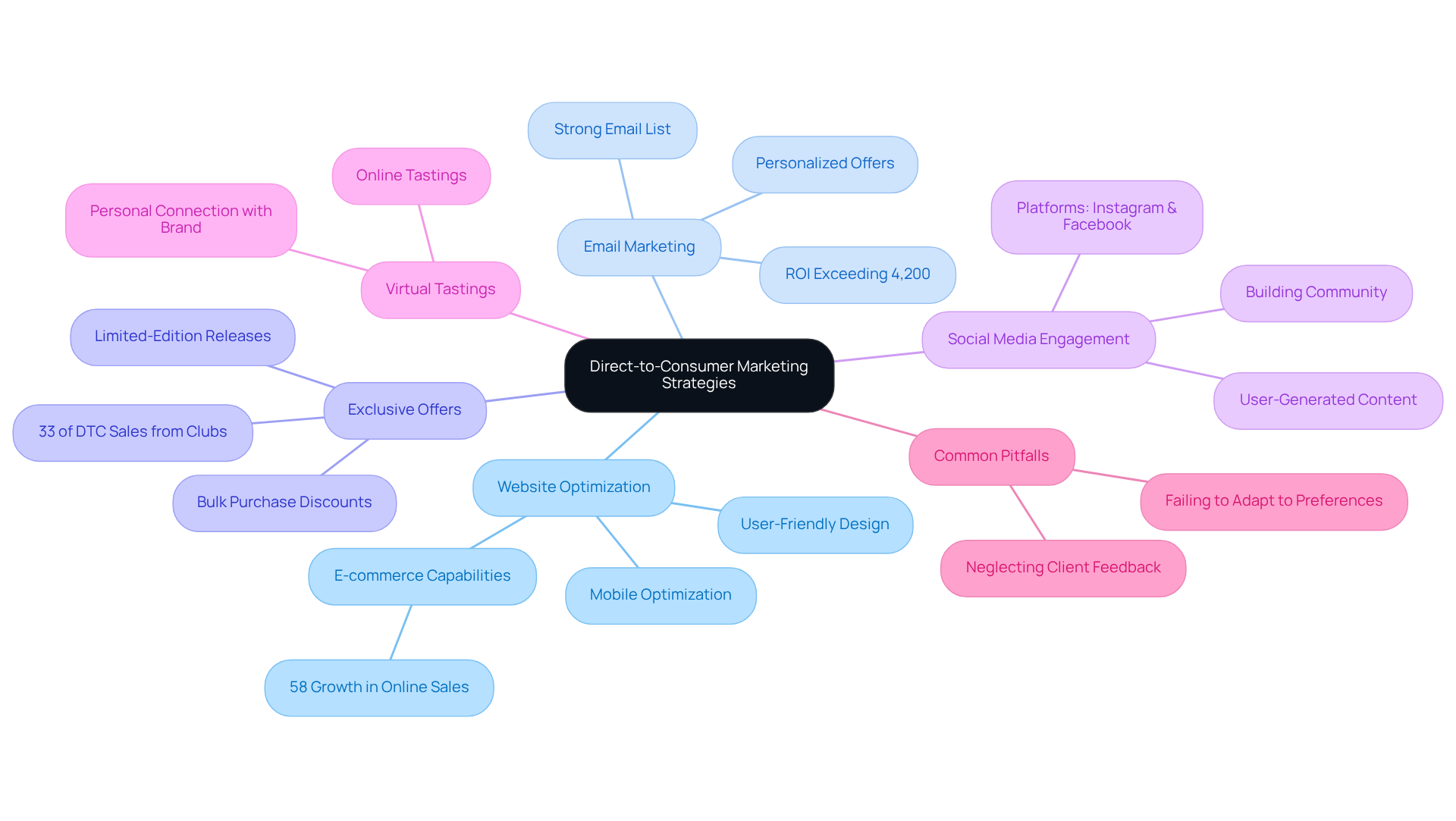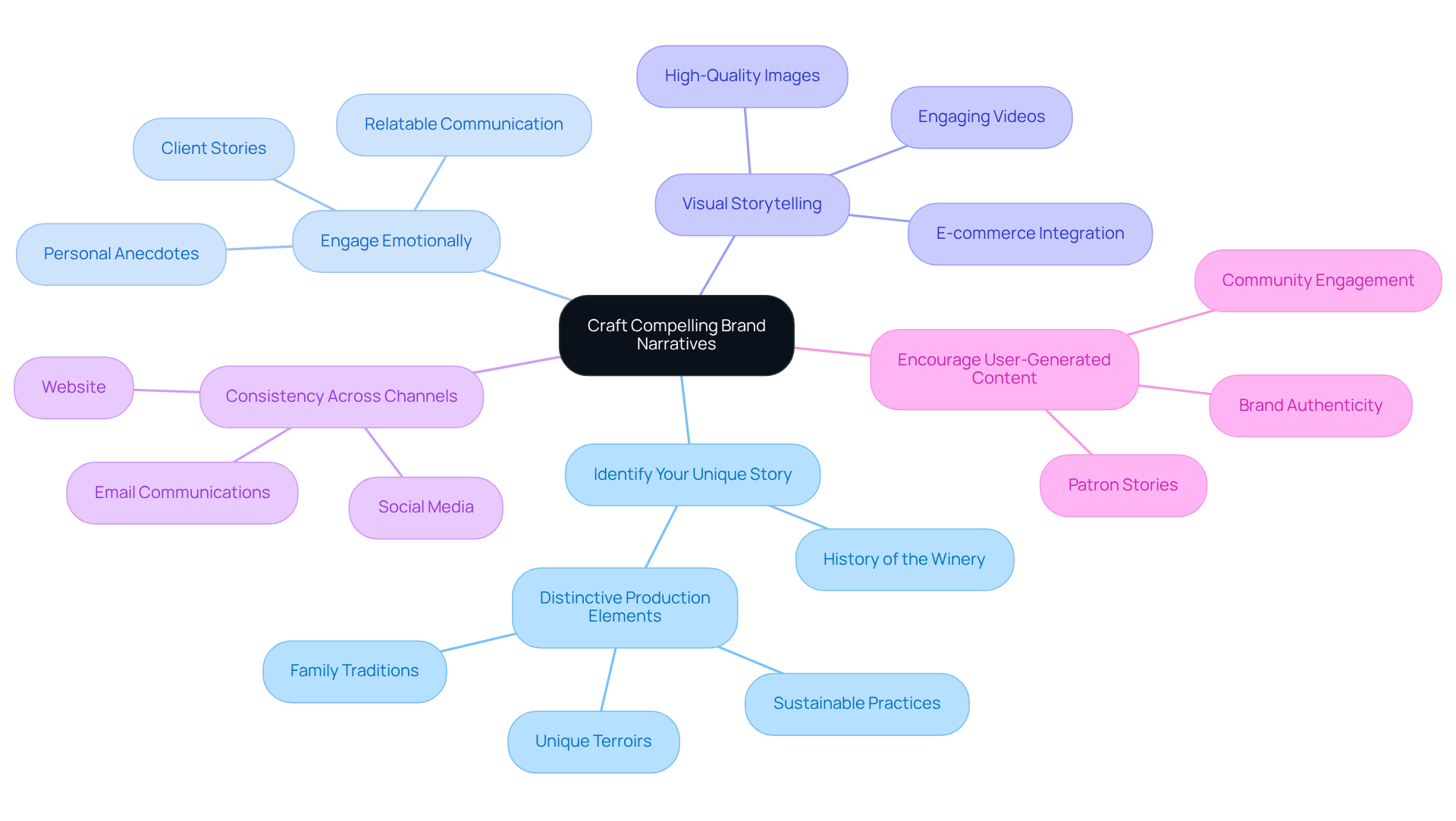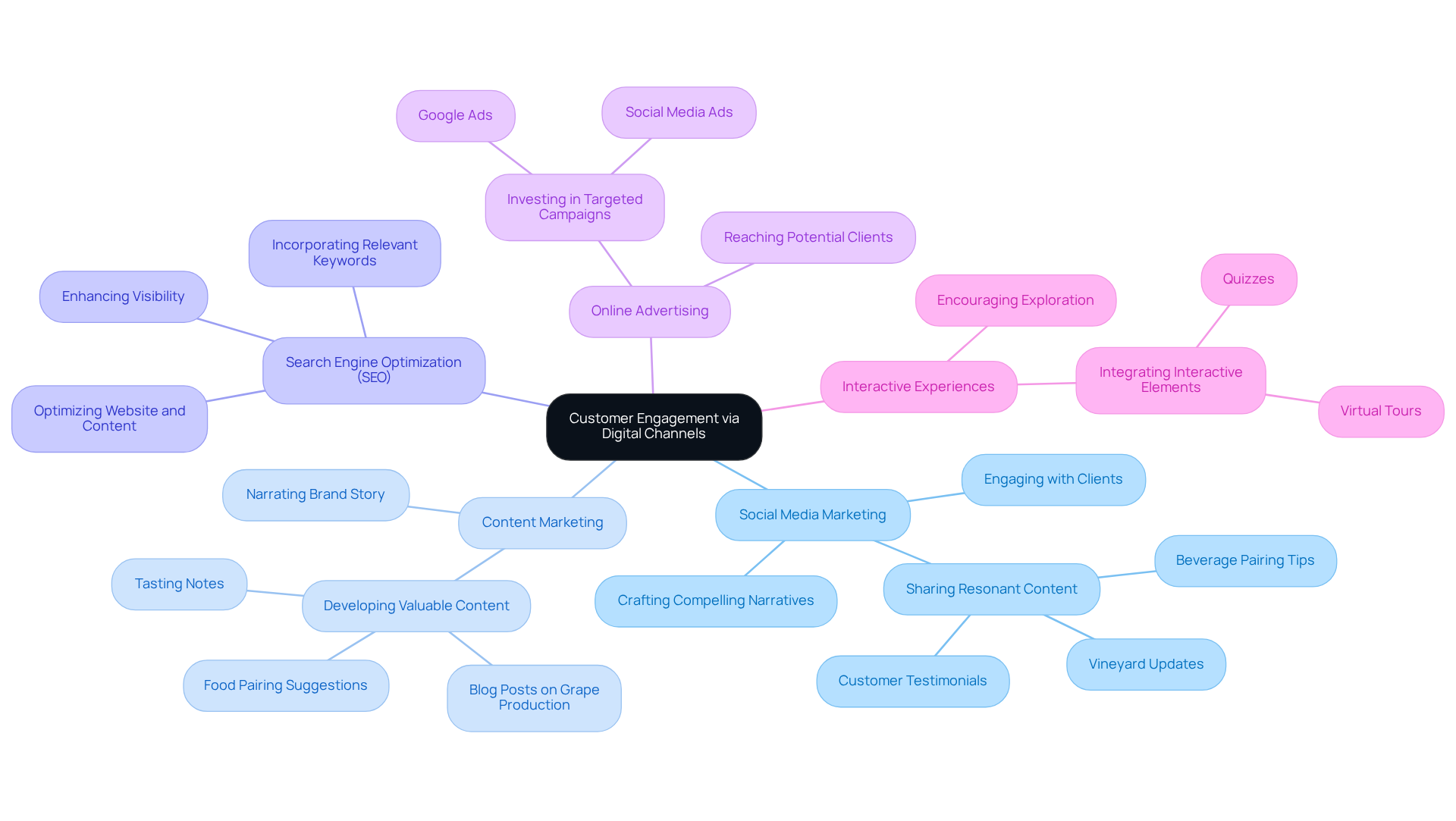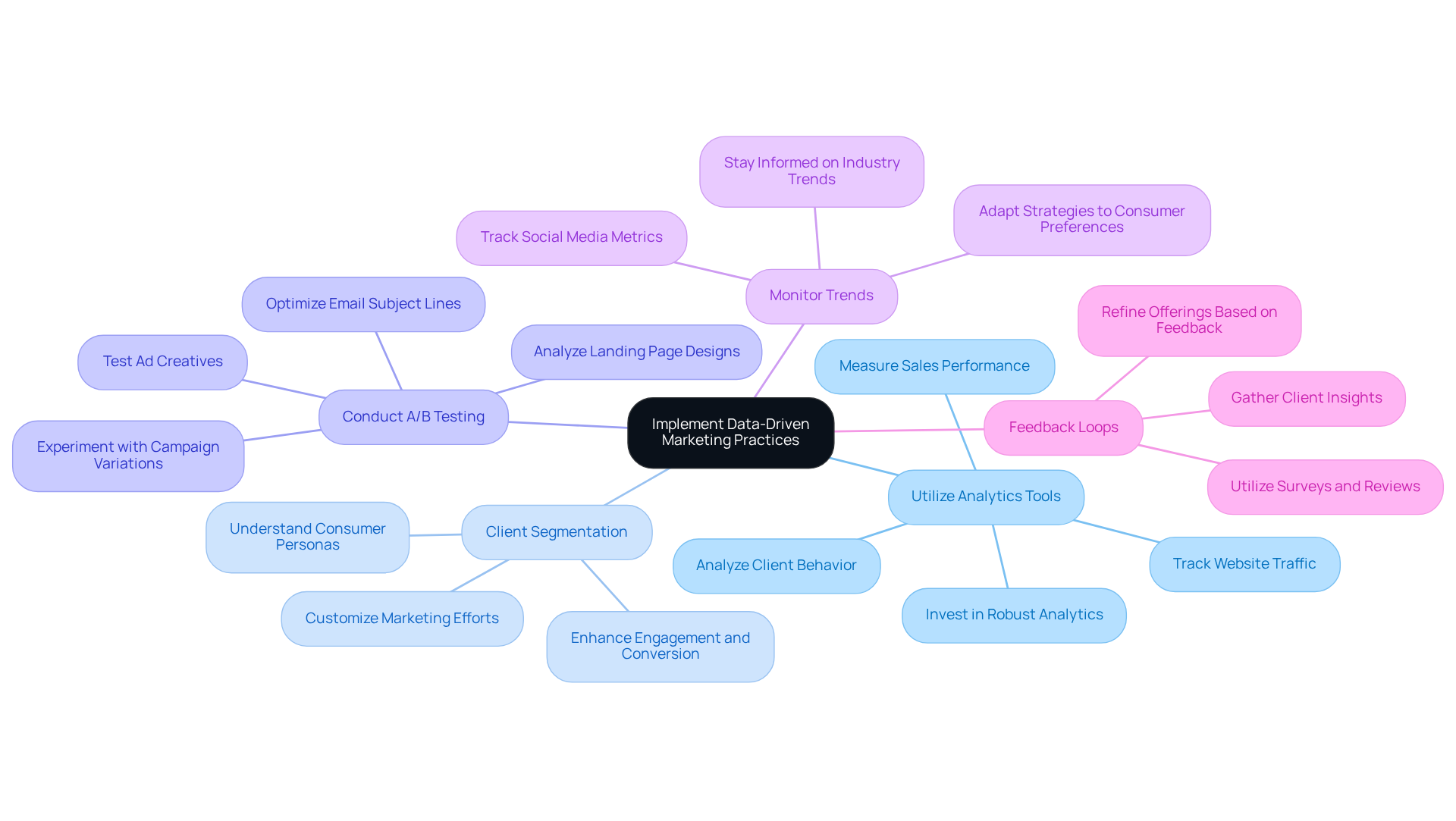Overview
This article presents proven strategies for wineries to master digital marketing and drive growth, highlighting the critical role of direct-to-consumer (DTC) marketing practices. By optimizing e-commerce websites, leveraging email marketing, engaging on social media, and employing data-driven techniques, wineries can significantly enhance customer relationships and boost sales. Supported by compelling statistics, these strategies demonstrate their effectiveness in increasing online sales and fostering brand loyalty. As the wine industry evolves, embracing these digital marketing tactics is essential for sustained growth and success.
Introduction
In an industry where tradition meets innovation, wineries are increasingly embracing digital marketing to enhance direct-to-consumer sales and cultivate enduring customer relationships. By harnessing tailored strategies—such as compelling brand narratives and data-driven practices—wineries can significantly elevate their online presence while engaging their audience more effectively.
However, given the rapid evolution of consumer preferences and digital tools, the pressing question remains: how can wineries adeptly navigate this complex landscape to ensure sustainable growth and foster loyalty?
Develop Direct-to-Consumer Marketing Strategies
To develop effective direct-to-consumer (DTC) marketing strategies, wineries must prioritize the following key practices:
- To excel in digital marketing wine, it is essential to have a user-friendly, mobile-optimized website with robust e-commerce capabilities. This primary touchpoint can significantly enhance conversion rates. According to a study by Wines & Vines, wineries that utilize digital marketing wine to optimize their e-commerce sites experience a remarkable 58% growth in online sales.
- Leverage Email Marketing: Building a strong email list and segmenting your audience for personalized offers is crucial. Email marketing boasts a potential ROI surpassing 4,200%, making it one of the most efficient channels for boosting sales in the digital marketing wine industry, as noted by the Direct Marketing Association.
- Create Exclusive Offers: Developing enticing promotions for club members and online customers, such as limited-edition releases or bulk purchase discounts, can encourage direct purchases and foster loyalty. Notably, clubs can represent up to 33% of a winery’s DTC sales, according to Silicon Valley Bank’s Wine Report.
- Utilize digital marketing wine by engaging with your audience on platforms like Instagram and Facebook, sharing behind-the-scenes content, beverage education, and user-generated stories that not only build community but also enhance brand loyalty. This is especially significant among younger consumers who value authentic connections. Crafting compelling narratives that resonate with consumers is essential for driving sales and fostering loyalty in the realm of digital marketing wine.
- Host Virtual Tastings: Organizing online tastings through digital marketing wine allows consumers to experience your wines from the comfort of their homes. This approach not only drives sales but also cultivates a personal connection with your brand, appealing to the increasing demand for virtual experiences in the post-pandemic landscape.
- Common Pitfalls: Wineries must be vigilant against when implementing these strategies, such as neglecting to examine client feedback or failing to adapt to evolving consumer preferences. For instance, overlooking the importance of customer reviews can lead to missed opportunities for improvement. Addressing these issues proactively is vital for the success of your digital marketing wine efforts. Furthermore, strategic capital planning can support these initiatives, ensuring that vineyards possess the resources required to execute these transformative approaches effectively. Enocap offers services such as demand generation strategies and club optimization to assist vineyards in overcoming these challenges.

Craft Compelling Brand Narratives
To craft compelling brand narratives, wineries must employ strategic approaches that resonate with their audience:
- Identify Your Unique Story: Reflect on the history of your winery, the individuals behind it, and the distinctive elements of your production. This could encompass family traditions, sustainable practices, or unique terroirs that set your brand apart. Highlighting these distinctive features is crucial for unlocking direct-to-consumer revenue through digital marketing wine and cultivating a devoted clientele.
- Engage Emotionally: Utilize storytelling techniques that evoke emotions. Share personal anecdotes or client stories that illustrate how your beverages enhance special moments, fostering a deeper connection with your audience. Notably, younger generations favor simple, relatable communication and seek personal experiences, making this approach particularly effective in transforming casual buyers into loyal club members.
- Visual Storytelling: Leverage high-quality images and videos to complement your narrative. Visual content significantly enhances the storytelling experience, rendering it more engaging and memorable for your audience. In today's digital landscape, especially within the context of e-commerce growth and digital marketing wine, high-quality visuals are essential for capturing attention and driving engagement.
- Consistency Across Channels: Ensure that your brand narrative remains consistent across all marketing platforms, including your website, social media, and email communications. This consistency builds a cohesive brand identity that consumers can trust and relate to, which is crucial for effective digital marketing wine strategies.
- Encourage User-Generated Content: Invite patrons to share their own stories and experiences with your wines. This not only enriches your brand narrative but also fosters a sense of community and engagement, making your brand more relatable and authentic. User-generated content has proven effective in boosting brand loyalty and nurturing a vibrant community around your establishment, ultimately supporting sustainable growth.

Utilize Digital Channels for Customer Engagement
To effectively leverage digital channels for customer engagement, wineries must adopt strategic practices, bolstered by Enocap's extensive advisory services:
- Social Media Marketing: Actively engage with clients on social media platforms. Share content that resonates with your audience, including beverage pairing tips, vineyard updates, and customer testimonials. Enocap specializes in crafting compelling narratives that connect with consumers, enhancing your social media presence through digital marketing wine and driving engagement.
- Content Marketing: Develop valuable content that both educates and entertains your audience. This could encompass blog posts about grape production, tasting notes, or food pairing suggestions. With Enocap's expertise in digital marketing wine, wineries can effectively , driving sales and fostering loyalty.
- Search Engine Optimization (SEO): Optimize your website and content for search engines to enhance visibility. Incorporate relevant keywords related to your wines and the wine industry to attract organic traffic. Enocap's strategic capital planning ensures you possess the necessary resources for effective SEO, which is essential for digital marketing wine, contributing to measurable outcomes such as increased online visibility.
- Online Advertising: Invest in targeted online advertising campaigns, such as Google Ads or social media ads, to reach potential clients who may not yet be aware of your brand. Enocap's demand generation approaches can significantly enhance the effectiveness of your digital marketing wine efforts, potentially leading to substantial e-commerce growth.
- Interactive Experiences: Integrate interactive elements on your website, such as quizzes or virtual tours, to engage visitors and encourage them to explore your offerings further. By transforming casual purchasers into dedicated club members, Enocap's proven strategies can elevate engagement and retention, ultimately supporting your growth objectives.

Implement Data-Driven Marketing Practices
To successfully implement data-driven marketing practices that align with Enocap's strategic capital advisory services, wineries must prioritize the following strategies:
- Utilize Analytics Tools: Investing in robust analytics tools is essential for tracking website traffic, client behavior, and sales performance. Platforms like Google Analytics and integrated social media insights provide valuable data that can inform strategic decision-making and optimize digital marketing wine strategies, ultimately unlocking direct-to-consumer revenue.
- Client Segmentation: Dividing the client base allows vineyards to customize their marketing efforts. By understanding diverse consumer personas and recognizing that segments can shift based on buying habits, vineyards can create tailored approaches in digital marketing wine that resonate with specific groups, enhancing engagement and conversion rates. Successful wineries recognize that digital marketing wine strategies, along with strategic segmentation, foster stronger and more profitable relationships with clients, transforming casual buyers into loyal club members.
- Conducting A/B testing on various digital marketing wine campaigns is crucial for identifying what resonates best with the audience. This may involve experimenting with different email subject lines, ad creatives, or landing page designs to determine which variations yield the highest engagement and conversion rates. Notably, segmented email campaigns generate 30-50% higher open rates than non-segmented ones, underscoring the value of this practice in driving consistent growth.
- Monitor Trends: Staying informed about industry trends and evolving consumer preferences through market research is vital. Wineries that adapt their strategies to incorporate can better position themselves in a competitive landscape. Additionally, tracking social media metrics in the context of digital marketing wine can reveal audience engagement and the effectiveness of content, providing further insights into market dynamics that can guide strategic capital planning.
- Feedback Loops: Establishing feedback mechanisms is essential for gathering insights from clients. Utilizing surveys and reviews can yield valuable information regarding customer satisfaction and highlight areas for improvement, enabling wineries to refine their offerings through digital marketing wine strategies and enhance the overall customer experience, ensuring they thrive for generations.

Conclusion
Mastering digital marketing in the winery sector is essential for driving growth and enhancing direct-to-consumer relationships. By adopting a multifaceted approach—including optimizing e-commerce platforms, leveraging email marketing, and crafting compelling brand narratives—wineries can significantly boost their visibility and sales. The integration of data-driven practices empowers wineries to make informed decisions, ensuring that their marketing strategies resonate with evolving consumer preferences.
Key strategies underscore the importance of:
- A user-friendly website
- The power of personalized email campaigns
- The effectiveness of engaging storytelling through social media
Additionally, hosting virtual tastings and utilizing analytics tools are crucial for creating memorable customer experiences and fostering loyalty. By avoiding common pitfalls and proactively adapting to feedback, wineries can position themselves for sustainable success in a competitive marketplace.
In conclusion, the digital landscape presents wineries with unprecedented opportunities to connect with consumers and drive sales. Embracing these marketing strategies not only enhances brand visibility but also cultivates lasting relationships with customers. Wineries are urged to take actionable steps today to implement these proven strategies, ensuring they thrive in the ever-evolving world of digital marketing.
Frequently Asked Questions
What are the key practices for developing effective direct-to-consumer (DTC) marketing strategies for wineries?
Wineries should prioritize having a user-friendly, mobile-optimized website with strong e-commerce capabilities, leveraging email marketing, creating exclusive offers, engaging on social media, hosting virtual tastings, and being aware of common pitfalls.
Why is having a mobile-optimized website important for wineries?
A mobile-optimized website enhances conversion rates significantly, as it serves as the primary touchpoint for consumers. Wineries that optimize their e-commerce sites can experience up to a 58% growth in online sales.
What is the potential ROI of email marketing in the digital marketing wine industry?
Email marketing has a potential ROI that surpasses 4,200%, making it one of the most efficient channels for boosting sales.
How can exclusive offers benefit wineries?
Exclusive offers, such as limited-edition releases or bulk purchase discounts, can encourage direct purchases and foster customer loyalty. Wine clubs can account for up to 33% of a winery’s DTC sales.
What role do social media platforms play in a winery's marketing strategy?
Engaging with audiences on platforms like Instagram and Facebook helps build community and enhance brand loyalty by sharing behind-the-scenes content, beverage education, and user-generated stories.
How can hosting virtual tastings benefit wineries?
Virtual tastings allow consumers to experience wines from home, driving sales and creating a personal connection with the brand, which is increasingly important in the post-pandemic landscape.
What common pitfalls should wineries avoid when implementing DTC marketing strategies?
Wineries should avoid neglecting client feedback, failing to adapt to evolving consumer preferences, and overlooking the importance of customer reviews, as these can lead to missed opportunities for improvement.
How can strategic capital planning support DTC marketing initiatives?
Strategic capital planning ensures that vineyards have the necessary resources to execute their marketing strategies effectively. Services like demand generation strategies and club optimization can assist wineries in overcoming challenges.




